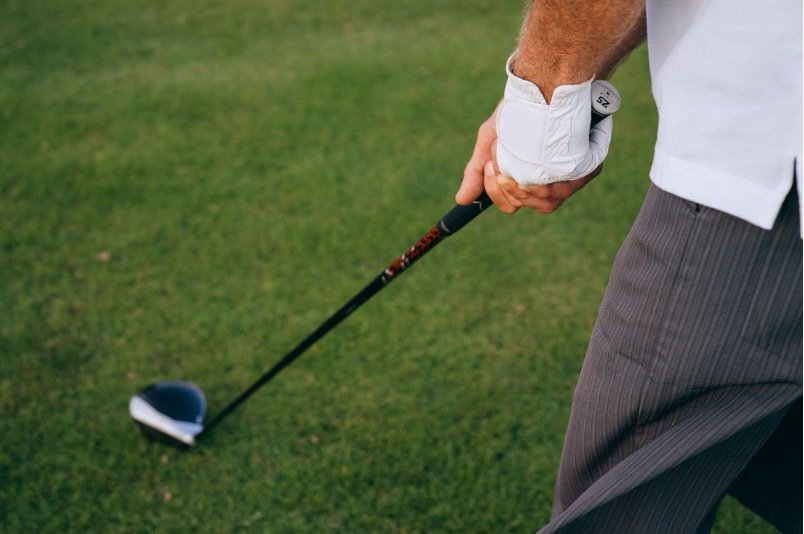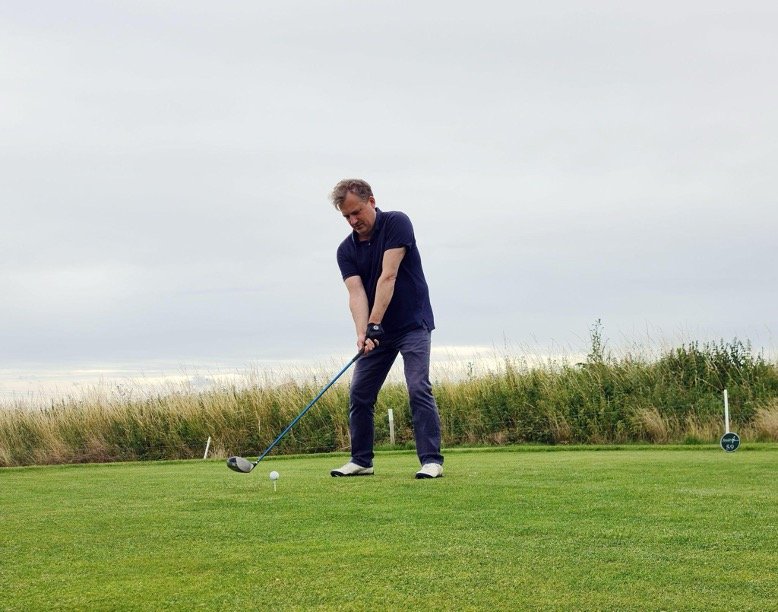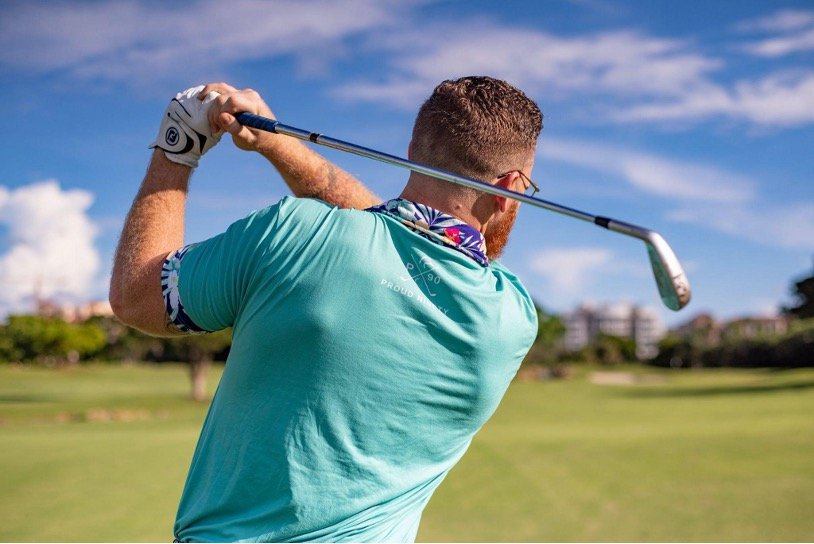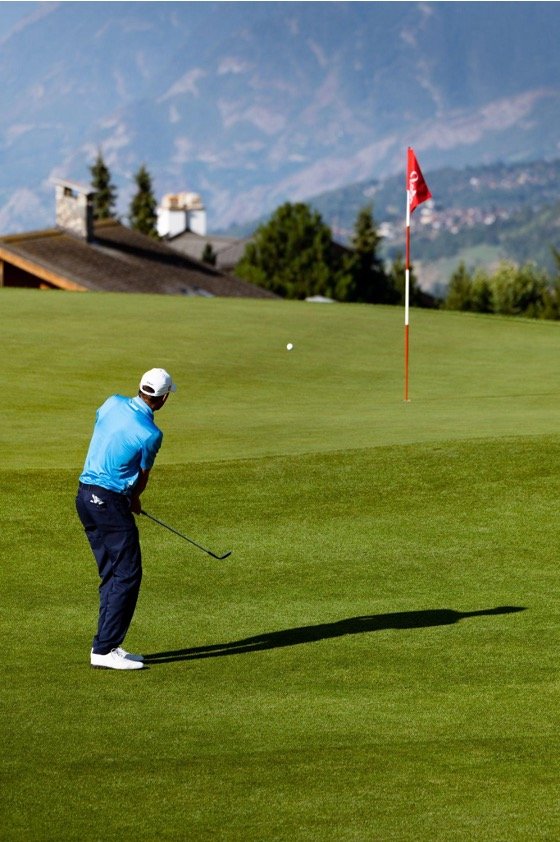How to hit a golf ball correctly

A golfer striking a ball | @nadimshaikh
Ball striking is the cornerstone of the game. Each stroke is a testament to a golfer’s skill, an artful communion between player and ball that defines excellence on the fairways. Understanding the fundamentals is paramount. From the grip that provides control to the stance ensuring balance and power, these foundational elements shape the art of hitting a golf ball. Let’s dissect the components of a good golf swing.
1. Stance and Alignment
Achieving a successful golf shot begins with a setup that establishes a foundation for a fluid and powerful swing. The alignment of the body with the target, along with precise positioning of the feet, hips, and shoulders, plays a pivotal role in ensuring accuracy and consistency on the course.

A golfer striking a ball | @nadimshaikh
A good stance can be developed by practicing the tips highlighted below.
- Positioning of the Feet: The first step in a proper setup is the careful positioning of the feet. Stand with your feet shoulder-width apart, creating a stable base. Distribute your weight evenly on both feet, allowing for a balanced foundation. The alignment of the feet should be parallel to the target line, ensuring that your body is set up for a straight and accurate shot.
- Alignment of the Hips:
The hips play a crucial role in maintaining balance and facilitating a smooth turn during the swing. Position your hips parallel to the target line, mirroring the alignment of your feet. This helps establish a consistent swing plane, reducing the likelihood of slicing or hooking the ball.
- Alignment of the Shoulders:
Align your shoulders parallel to the target line, creating a harmonious connection with your feet and hips. This alignment promotes a natural swing path and ensures that your clubface is oriented toward the target.
- Body Alignment with the Target:
The overall alignment of your body should be directed towards the target. This includes the extension of an imaginary line from your target through your body and out to the distance you want the ball to travel.
2. Grip Technique

A golfer’s grip | @mikhailnilov
The significance of a correct grip in golf cannot be overstated, as it serves as the linchpin for effective ball control. A golfer’s grip on the club not only influences the swing’s dynamics but also plays a pivotal role in dictating the clubface’s position at impact, ultimately determining the trajectory and accuracy of the shot.
3. Posture and Body Position

A golfer hitting the ball | @martinmagnemyr
The foundation for a consistent and powerful swing is established through careful attention to the spine angle, overall posture at setup, and the distribution of weight to ensure stability throughout the swing.
At the setup, a golfer’s spine angle is instrumental in creating the optimal platform for an effective swing. The spine should be tilted slightly away from the target, promoting a natural and dynamic rotation during the swing. This slight tilt ensures that the shoulders are aligned correctly and encourages a more powerful and on-plane swing. Additionally, a straight and neutral posture with a slight knee flex provides the flexibility and range of motion necessary for a fluid swing.
Weight distribution is another key component of maintaining stability throughout the golf swing. The weight should be evenly distributed between both feet, creating a balanced foundation.
4. Swing Mechanics

A backswing | @stevemomot
The golf swing involves a carefully orchestrated sequence of movements. Understanding the dynamics of the swing sequence, from the backswing to the follow-through, is essential for mastering the art of striking the ball with precision and power.
- Backswing Fundamentals: The backswing serves as the precursor to a well-executed golf shot. Fundamentally, it involves a controlled rotation of the body to create torque and store energy.
Key considerations during the backswing include;
Rotation of the Hips and Shoulders: Initiating the backswing involves a coordinated turn of the hips and shoulders. The hips rotate to shift weight to the trail leg, while the shoulders pivot to create the necessary coil.
Maintaining a Stable Spine Angle: A stable spine angle ensures consistency and control throughout the swing. The spine should maintain its tilt away from the target, allowing for a more efficient transfer of energy during the downswing.
Downswing techniques: The transition from the backswing to the downswing is a critical phase where the stored energy is unleashed with precision.

Downswing | @hugosykes
Key considerations include:
- Initiation with the Lower Body: The downswing begins with a lateral shift of the lower body, transferring the weight from the trail side to the lead side. This movement facilitates a powerful sequence, allowing the club to approach the ball from the inside.
- Maintaining Lag and Angle: Lag, the angle between the club shaft and the left forearm, is crucial for generating clubhead speed. Maintaining this angle until just before impact allows for a crisp and powerful strike.
- Impact Position: At impact, the body should be rotated open, with the hands leading the clubhead. The weight is predominantly on the lead foot, ensuring a descending strike for crisp ball contact.
4. Club Selection

A golf club | @bennyhassum
Selecting the right golf club is an art that significantly influences the outcome of each shot. A strategic approach to club selection involves understanding the characteristics of different clubs and assessing the distance and conditions to optimize performance.
Understanding the Characteristics of Different Clubs
Each golf club in the bag has distinct characteristics designed for specific shot requirements. Understanding these characteristics is fundamental to making informed club selections:
- Woods: Woods, typically with larger clubheads, are suitable for long-distance shots off the tee or fairway. They are designed for maximum distance, making them ideal for reaching the green on longer holes.
- Irons: Irons are versatile clubs that come in various numbered sets, each with a specific loft angle. Lower-numbered irons (2-5) are designed for longer shots, while higher-numbered irons (6-9) offer more loft for approach shots and precision.
- Wedges: Wedges, including the pitching wedge, sand wedge, and lob wedge, provide high loft for shots requiring height and short-distance control. They are crucial for approach shots and shots around the green.
- Hybrids: Hybrids combine elements of both woods and irons, offering forgiveness and distance. They are often preferred for challenging lies and longer approach shots.
- Putters: Putters are specialized for the green and are essential for precision and control during putting. They are designed for shorter, delicate shots on the putting surface.
Optimal Club Selection
Optimal club selection involves a thoughtful analysis of both distance and course conditions to match the club to the specific shot requirements:
- Distance Considerations: Evaluate the distance to the target and refer to the club’s typical distance range. Factors such as wind, elevation changes, and course conditions must be considered to adjust for accurate distance calculations.
- Course Conditions: Assessing course conditions involves considering factors such as the lie of the ball, the rough or fairway type, and any hazards or obstacles. Different clubs offer varying levels of forgiveness and versatility in handling different conditions.
- Shot Trajectory: The desired trajectory of the shot is crucial. Low-trajectory shots may require a longer iron or hybrid, while high-trajectory shots around obstacles may benefit from a lofted club.
- Consideration of Hazards: Evaluate the presence of hazards, such as bunkers or water, and select a club that helps navigate these obstacles. Conservative club choices may be prudent when faced with challenging course features.
5. Visualization and Focus
The mental aspect of hitting a golf ball is a crucial component that can elevate a player’s performance from good to great. Visualization and focus, two interrelated elements, play a very important role in shaping a golfer’s mindset and influencing the outcome of each shot.
- Visualizing the Desired Shot:
Visualization is a powerful tool that allows golfers to mentally rehearse and anticipate their shots before executing them. This process involves creating a vivid mental image of the desired shot trajectory, landing point, and overall outcome. Key aspects of visualization include:
Shot Trajectory: Golfers mentally trace the intended flight path of the ball, envisioning the arc it will take through the air. This visualization helps in aligning the body and club to execute the shot as intended.
Landing Spot: Imagining the precise location where the ball should land on the fairway or green aids in distance control and accuracy. Visualization of the landing spot guides the golfer’s focus on a specific target.
Positive Outcome: Envisioning a successful shot, whether it’s a well-struck drive down the fairway or a precise approach shot to the green, instills confidence and primes the mind for success.
- Focusing on Target and Maintaining Concentration:
Focus and concentration are essential mental attributes that contribute to successful golf shots. This involves maintaining a heightened level of awareness and mental clarity throughout the entire swing sequence. Key aspects of focus include:
Target Alignment: Before taking a shot, golfers align themselves with the target, focusing on a specific point in the distance. This alignment ensures that the swing is oriented toward the intended target, increasing the likelihood of a successful shot.
Pre-shot Routine: Establishing a consistent pre-shot routine helps golfers transition from visualization to execution. This routine includes visualizing the shot, aligning with the target, and taking a moment to mentally prepare for the upcoming swing.
Blocking Out Distractions: Golfers must cultivate the ability to block out external distractions and maintain concentration on the task at hand. Whether it’s the environment, other players, or internal thoughts, maintaining focus is essential for consistent performance.
Shot-by-Shot Mindset: Golf is a game of moments, and focusing on one shot at a time is paramount. By adopting a shot-by-shot mindset, golfers prevent past mistakes or future challenges from affecting their current performance.
Common Mistakes and Corrections
Ball striking in golf is an intricate skill that demands precision. Common errors, such as slices, hooks, and challenges with distance and accuracy, can hinder a golfer’s performance. Let’s explore effective strategies to correct these frequent mistakes and enhance overall ball-striking proficiency.
- Slice and Hook Corrections:
Slice Correction:
Grip Adjustment: A slice often results from an open clubface at impact. Adjust your grip by rotating both hands slightly to the right (for right-handed golfers). This promotes a more closed clubface and helps counteract the slice.
Inside-Out Swing Path: A slice is frequently associated with an outside-in swing path. Focus on swinging the club more from the inside to the outside. This adjustment minimizes the sidespin that causes the slice.
Hook Correction:
Grip Modification: A strong grip, where both hands turn excessively to the right (for right-handed golfers), can lead to a hook. Adjust your grip to a more neutral position, reducing the likelihood of the clubface closing too much.
Balanced Weight Shift: A hook may result from an aggressive lower body and an overactive release. Ensure a balanced weight shift during the swing, and focus on a smoother release to control the amount of clubface rotation.
- Troubleshooting Issues with Distance and Accuracy:
Distance Issues: Proper Weight Transfer: Inconsistent weight transfer can limit the power generated in the swing. Ensure a smooth weight shift from the trail foot to the lead foot during the downswing to maximize clubhead speed.
Complete Body Rotation: A restricted body turn can compromise both distance and accuracy. Allow for a full rotation of the hips and shoulders, unleashing the full potential of your swing.
Accuracy Issues:
Alignment Check: Poor alignment can lead to inaccurate shots. Regularly verify your alignment with the target, ensuring that your feet, hips, and shoulders are parallel to the intended target line.
Consistent Tempo: An erratic tempo disrupts rhythm and can result in inaccurate shots. You should develop a smooth and consistent tempo throughout your swing, avoiding sudden speed changes.
Combating Both Distance and Accuracy Issues:
Clubfitting: Ensure that your clubs are properly fitted for your swing. A well-fitted set of clubs can contribute significantly to both distance and accuracy.
Professional Instruction: You can seek guidance from a qualified golf professional to analyze your swing and provide personalized corrections. Professional advice can address specific issues tailored to your unique swing mechanics.
Summary
Embrace a structured practice routine that incorporates purposeful drills, leverages technology for feedback, and hones in on specific areas for refinement. As you navigate the green, remember that each swing is an opportunity to learn, adapt, and grow. Encourage yourself to embrace challenges, celebrate successes, and approach every practice session with a spirit of curiosity and determination.